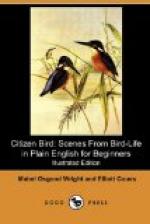Under parts white, tinged in summer with buff on the breast and at all seasons mottled there with dusky.
Middle tail feathers blackish, the other ones plain gray with white edgings, but without any black cross-bars. Bill black; feet greenish-gray, with a small hind toe like other Sandpipers’, but no sign of any web at the roots of the front toes.
A Citizen of North America, nesting far north, beyond the United States, and travelling in large flocks in the fall to the West Indies and South America.
A member of the guild of Ground Gleaners. It belongs to a family of game birds, but it is a shame to shoot such a mite of a bird for the morsel of meat its tiny body affords—hardly one mouthful.
There is a brother of the Least Sandpiper, hardly any bigger, and so much like it that you can hardly tell them apart, unless you notice that this one has two little webs between the roots of the front toes. This is the Semipalmated Sandpiper, for semipalmated means “half-webbed,” as its toes are. Both kinds are called “Peeps” by people who do not know the difference between them.
The Virginia Rail
Length nine and half inches, of which the long, slender, curved bill makes an inch and a half.
Upper parts mixed blackish and blown, growing brighter reddish-brown on the wings, a light line over the eye and a dark one through the eye.
Under parts mostly cinnamon color, but distinctly barred with black and white on the sides behind and under the tail and wings, the chin whitish.
Feet big and clumsy, with very long toes in front—about as long as the bill.
A Citizen of temperate North America, nesting in the Northern States and wintering in some of the Southern States.
A member of the guild of Ground Gleaners, who does us no harm and not much good, though it is a sort of game bird whose flesh is palatable, and it may be shot in the fall. It is not neighborly and is seldom seen, as it lives only in the thickest reeds or herbage of marshy places, where it can run over the softest mud, or even floating plants, by means of its long spreading toes, which keep it from slumping in.
“To-morrow, when the tide begins to come in, we are going to fish for bluefish!” interrupted Nat joyfully. “Olaf says they are beginning to run, and there are lots of crabs to catch up in the creek too—only I’m afraid that there won’t be half time enough for everything.”
“How can fish run when they have no legs?” objected Dodo, who had not quite finished writing her tables and did not like to be hurried. And then, too, she was a little lady who took things literally, and liked to have them exactly right.
CHAPTER XXX
DUCKS AND DRAKES




